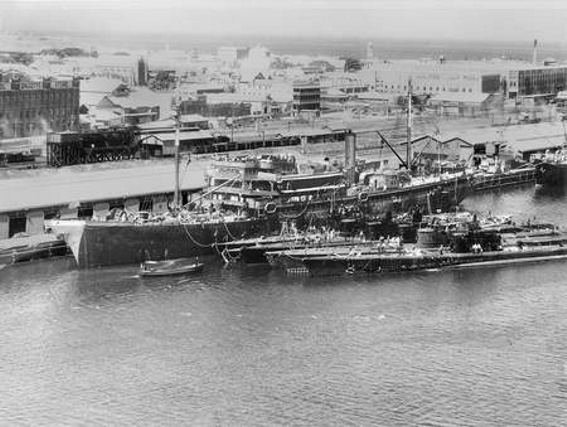 | ||
Fremantle submarine base was the utilisation of Fremantle Harbour as a submarine base in World War II.
Contents
Secrecy
Knowledge of its existence was very carefully guarded as a wartime secret. However, in August 1945, newspaper reports openly acknowledged the impact of the forces' activity.
Response to Japanese Scare of March 1942
See also Western Australian emergency of March 1942The establishment of the base was directly related to what was known as the Japanese Scare of March 1942, the most significant event for Western Australia being the attack on Broome.
The base later became a major US Navy facility, with submarines based there attacking Japanese shipping throughout South East Asia. It involved mainly submarines from the US navy, but also included submarines from other forces.
Utilisation
When it was fully active the base saw 160 Dutch, American and British submarines pass through the harbour.
The base was tied in with the Indian Ocean campaign of 1942–45. Military historians looking at the strategy in the South East Asian Theatre look upon the command of the Commander Submarines, South West Pacific (COMSUBSOWESPAC), and the facility of the Fremantle base as integral to successes in 1943 onwards.
Establishments
Various buildings and properties in Fremantle were requisitioned as part of the support of the base, and remained so until late 1945. Other facilities further from the coast were also utilised for support, such as the Byford armament depot, which stored torpedoes and mines. Also anti-aircraft gun installations were set up near the base.
Coastal defences for the seaward approaches to Fremantle, included batteries on Rottnest Island (2), the suburban beaches between Swanbourne and Point Peron at the lower end of Cockburn Sound (3), Garden Island (4), as well as at the mouth of the harbour (2).
Heavy anti-aircraft gun stations were concentrated mostly along the coast around Cockburn Sound. The northernmost was at Cottesloe, and the southernmost was at South Rockingham. Light anti-aircraft gun sites were much more confined to the Fremantle Harbour area (8) and Swan River, Melville Water area (6). Also there were 20 anti-aircraft searchlight stations as back-up to the gun stations.
Effect on community
In 2014, the work by Deborah Gare and Madison Lloyd-Jones When war came to Fremantle 1899–1945 gives a pictorial and textual understanding of the impact of the allied servicement associated with the submarine base. Also collections of oral history in Battye Library include numbers of people remembering from their childhood the impact of the base, and of American servicemen living in Perth in the 1940s.
Submarine tenders and assisting ships
Refits and repairs
Submarines known to have been repaired or refitted at Fremantle include:
Losses
The numbers of submarines lost that had utilised the Fremantle submarine base included:
Lost in 1943
Lost in 1944
Lost in 1945
Dismantling base and facilities
In September 1945 at the end of the war, the dismantling of the submarine base included the USS Anthedon (AS-24) being involved with removing submarine repair facilities.
Memorial
The most significant memorial to lost submariners who had been based in Fremantle is the periscope project on Memorial Hill, Fremantle.
